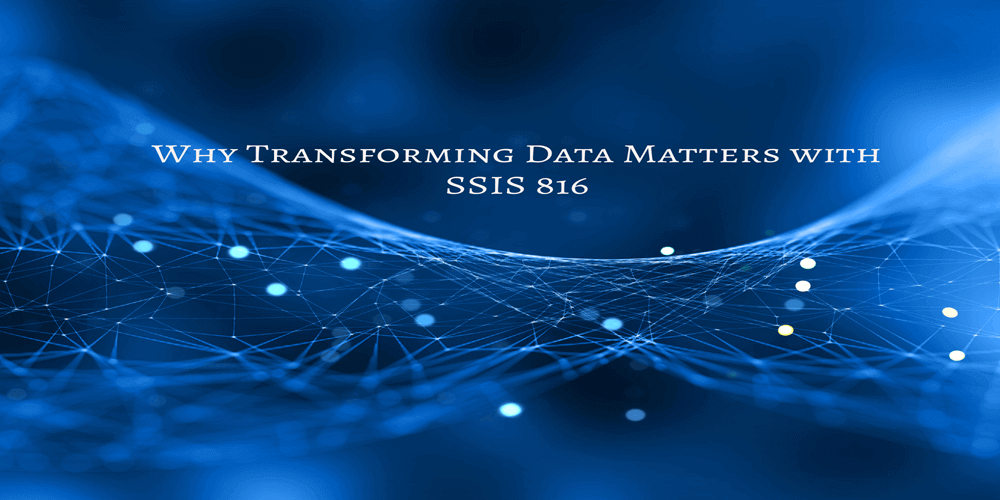The ability to extract information from unprocessed data is a vital competence. Data transformation is a way to convert data into a structured format. Formatted data is simpler to access, comprehend, and use for analysis. Whether you work as an analyst, data scientist, or in business, knowing and using efficient data transformation techniques can greatly improve your capacity for extracting insightful information. This article will discuss why SSIS 816 is best for data transformation. Also, we will discuss data transformation significance, common methods, available resources, difficulties, and best practices.
Why Transforming Data Matters with SSIS 816
Enhancing Data Quality
Optimising data quality is one of the foremost objectives of data transformation. SSIS 816 can improve the quality of the data. Errors, outliers, and inconsistencies are prevalent in raw data, which can distort the outcomes of analyses. SSIS 816 can find and fix these problems. This tool is best in guaranteeing that the data is accurate and trustworthy, by using strategies like data cleaning.
Enabling Effective Analysis and Reporting
Analysing and visualising transformed data is easy. Data can be consolidated, summed up, and normalised using SSIS 816. It provides insightful information that raw, unprocessed data may not reveal. This makes reporting more accurate and assists with decision-making based on collected knowledge.
Facilitating Integration Across Platforms
SSIS 816 software also helps with data integration. Integration requires reliable information transformation in a world with diverse data sources and formats. After making data consistent across platforms, it is mandatory to check that different systems are working.
Supporting Decision-Making Processes
Data transformation is a significant step for making smart decisions. SSIS 816 facilitates the process of making decisions. It can organise data in a format that is easy to understand, stakeholders can quickly pick up on key trends and insights, which helps them make better strategic decisions.
Common SSIS 816 Techniques for Data Transformation
1. Data Cleaning
Data cleansing is the process of locating and removing outliers, errors, and inconsistencies from a specific set of data. This step is essential for maintaining the accuracy and reliability of data prior to analysis. In addition to Excel and Python libraries such as Pandas, SSIS 816 tool offers a variety of functions for data cleansing.
Illustrative Use Case: Ensuring the accuracy of misspellings and eliminating duplicate entries from a dataset containing customer information.
2. Data Aggregation
Combining discrete data points into summary statistics is known as data aggregation. This technology is used to examine trends or patterns. Aggregation methods such as summing, averaging, and determining maximum and minimum values are commonly used. Example Use Case: Using individual transaction records to figure out the monthly sales total.SSIS 816 can simplify the data aggregation task
3. Data Normalisation
Data normalization is the process of converting numerical data to a standardised range. While working with machine learning algorithms, it is important to perform data normalisation.SSIS 816 helps in data normalisation.
Example Use Case: Min-Max Scaling dataset features to 0–1.
Below are four commonly used normalisation techniques:
- scaling to a range
- clipping
- log scaling
- z-score
4. Data Encoding
The process of data encoding is important in handling categorical variables. The process comprises the transformation of categorical data into numerical form. This numerical format is suitable for utilization in mathematical models.SSIS 816 also does data encoding.
Example: Using label encoding, “red,” “green,” and “blue” labels are converted to numerical values (such as 0, 1, 2).SSIS 816 is the best tool for data encoding.
5. Data Transformation with Machine Learning
SSIS 816 uses Machine learning techniques like Feature Engineering and Principal Component Analysis (PCA) which are powerful tools for data transformation. These methods improve model performance by adding new features or reducing dataset dimensionality.
Example: Reducing a high-dimensional dataset’s dimensionality with PCA for quicker processing.
Tools for Data Transformation
Factors such as dataset size, complexity of transformation tasks, and familiarity with specific platforms all play a role in selecting the appropriate tool for data transformation. Popular options include Python libraries like Pandas, scikit-learn, and specialized data transformation platforms like Apache NiFi, SSIS 816, and Talend.
